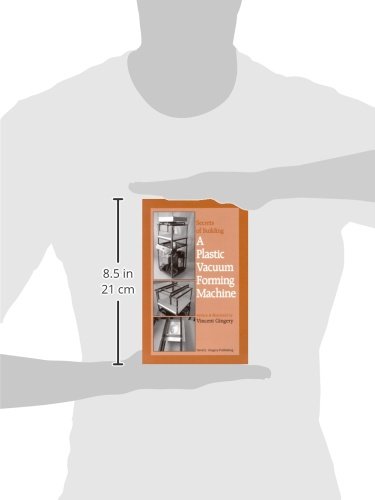Customer Services
Copyright © 2025 Desertcart Holdings Limited
Desert Online General Trading LLC
Dubai, United Arab Emirates



Full description not available
N**L
thankyou elite digital!!!!
very informative book, worth a read I found this book very useful to understand the science behind the vaccuum forming process in order to invent new manufacturing processes.
T**N
quite good but...
It's a good book but all measurements are in imperial units and not in metric... it would have been good if there been some sort of info of which measurements are being used.
M**N
Secrets of Building a Plastic Vacuum Forming Machine
Just like the title says. Everything you need to do, in detail , to build your own small vacuum forming machine. Typical of Gingery books, it is written in clear, unmistakable fashion that is easy for a tinkerer to get through.
H**T
Kinda OK...but...
Most of what is in this book is out on the web. Indeed I was searching for more information after looking through this book (yeah,that should tell ya something ;-))...and even found a pdf of the entire book out on the web...but I'd already purchased it from Amazon.Anyways...back to the book...my sons both build competition models for Wonderfest and are interested in trying vacuum forming on a large studio-scale model they have in mind for next year. They and I had watched "Introduction to Professional Model Making with Fon Davis" (note we have no interest in that video, nor do we own one of his machines.... nor do we know Fon...unfortunately!!) so perhaps my expectations were a bit high for a book written many years ago, read the rest of this review with that grain of salt in mind ;-)The style of table presented in this book, well...it looks cumbersome to use...the machines I've seen elsewhere, including those shown in Fon's video...(which by the way SHOULD be on your MUST list if you're just getting into vacuum forming) allow one to quickly move the plastic down to the mold...not the mold to the plastic...personally I prefer to have my working surface "fixed" not the other way around as in this table....also I really wonder if a single vacuum hole is sufficient? Would have thought there'd be a vacuum plenum underneath (not dissimilar to the vacuum clamps a lot of woodworkers use).The book does head down the right direction of discussing vacuum storage (tanks) and does a good job of explaining this design. Makes of use of "affordable" equipment to construct so kudos for that. You should be able to build a working unit based off of this design if you so choose.FYI, the heater element still seams to be available from several sources...but wondering if some other form of safer heating would be available now days.Overall, not sorry I bought it...but our table will not be based on this one's design primarily because of personal preferences.Would be nice to see an updated version of this book...with some improvements...but it did give us some ideas for our table.
T**S
Pretty good worth the money
The book is good overall. It has an in-depth instruction form building the machine on the front of the book. I gained little information about vacuum forming overall from the book. It really does not go into depth on the vacuum piping. The book does explain what a vacuum is in detail, which is very important. It explains how to utilize a vacuum for forming, and the different types of measurements of vacuum. It also goes over the different types of plastics. It spends a considerable amount of time talking about plastics. What I disliked about the book is that it failed to teach me why you make the decision on each area of building the machine. The book reads quickly. The writing style of the book is not overly complained with acronyms or industry phrasing. The author does a good job at explain in non-former terms.
Trustpilot
1 week ago
2 weeks ago